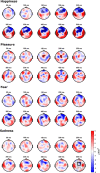Contributions of fundamental frequency and timbre to vocal emotion perception and their electrophysiological correlates
- PMID: 35522247
- PMCID: PMC9714422
- DOI: 10.1093/scan/nsac033
Contributions of fundamental frequency and timbre to vocal emotion perception and their electrophysiological correlates
Abstract
Our ability to infer a speaker's emotional state depends on the processing of acoustic parameters such as fundamental frequency (F0) and timbre. Yet, how these parameters are processed and integrated to inform emotion perception remains largely unknown. Here we pursued this issue using a novel parameter-specific voice morphing technique to create stimuli with emotion modulations in only F0 or only timbre. We used these stimuli together with fully modulated vocal stimuli in an event-related potential (ERP) study in which participants listened to and identified stimulus emotion. ERPs (P200 and N400) and behavioral data converged in showing that both F0 and timbre support emotion processing but do so differently for different emotions: Whereas F0 was most relevant for responses to happy, fearful and sad voices, timbre was most relevant for responses to voices expressing pleasure. Together, these findings offer original insights into the relative significance of different acoustic parameters for early neuronal representations of speaker emotion and show that such representations are predictive of subsequent evaluative judgments.
Keywords: event-related potentials (ERPs); fundamental frequency (F0); parameter-specific voice morphing; timbre; vocal emotion perception.
© The Author(s) 2022. Published by Oxford University Press.
Figures





Similar articles
-
Electrophysiological Correlates of Vocal Emotional Processing in Musicians and Non-Musicians.Brain Sci. 2023 Nov 7;13(11):1563. doi: 10.3390/brainsci13111563. Brain Sci. 2023. PMID: 38002523 Free PMC article.
-
Musicality - Tuned to the melody of vocal emotions.Br J Psychol. 2024 May;115(2):206-225. doi: 10.1111/bjop.12684. Epub 2023 Oct 18. Br J Psychol. 2024. PMID: 37851369
-
Vocal emotion adaptation aftereffects within and across speaker genders: Roles of timbre and fundamental frequency.Cognition. 2022 Feb;219:104967. doi: 10.1016/j.cognition.2021.104967. Epub 2021 Dec 4. Cognition. 2022. PMID: 34875400
-
Disentangling emotional signals in the brain: an ALE meta-analysis of vocal affect perception.Cogn Affect Behav Neurosci. 2023 Feb;23(1):17-29. doi: 10.3758/s13415-022-01030-y. Epub 2022 Aug 9. Cogn Affect Behav Neurosci. 2023. PMID: 35945478 Review.
-
Explaining the high voice superiority effect in polyphonic music: evidence from cortical evoked potentials and peripheral auditory models.Hear Res. 2014 Feb;308:60-70. doi: 10.1016/j.heares.2013.07.014. Epub 2013 Aug 3. Hear Res. 2014. PMID: 23916754 Review.
Cited by
-
Neural Correlates of Voice Learning with Distinctive and Non-Distinctive Faces.Brain Sci. 2023 Apr 7;13(4):637. doi: 10.3390/brainsci13040637. Brain Sci. 2023. PMID: 37190602 Free PMC article.
-
Vocal and Facial Behavior During Affect Production in Autism Spectrum Disorder.J Speech Lang Hear Res. 2025 Feb 4;68(2):419-434. doi: 10.1044/2024_JSLHR-23-00080. Epub 2024 Dec 19. J Speech Lang Hear Res. 2025. PMID: 39700465 Free PMC article.
-
Electrophysiological Correlates of Vocal Emotional Processing in Musicians and Non-Musicians.Brain Sci. 2023 Nov 7;13(11):1563. doi: 10.3390/brainsci13111563. Brain Sci. 2023. PMID: 38002523 Free PMC article.
-
Vocal Emotion Perception and Musicality-Insights from EEG Decoding.Sensors (Basel). 2025 Mar 8;25(6):1669. doi: 10.3390/s25061669. Sensors (Basel). 2025. PMID: 40292745 Free PMC article.
References
-
- ANSI . (1973). Terminology, Psychoacoustical. S3. 20. In: Terminology, New York: American National Standards Institute, Psychoacoustical.
-
- Arias P., Rachman L., Liuni M., Aucouturier J.J. (2021). Beyond correlation: acoustic transformation methods for the experimental study of emotional voice and speech. Emotion Review, 13(1), 12–24.
-
- Auton A. (2021). Red blue colormap. Available: https://www.mathworks.com/matlabcentral/fileexchange/25536-red-blue-colo... [June, 2021].
-
- Banse R., Scherer K.R. (1996). Acoustic profiles in vocal emotion expression. Journal of Personality and Social Psychology, 70(3), 614–36. - PubMed

